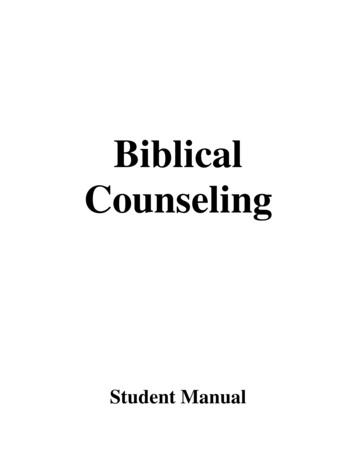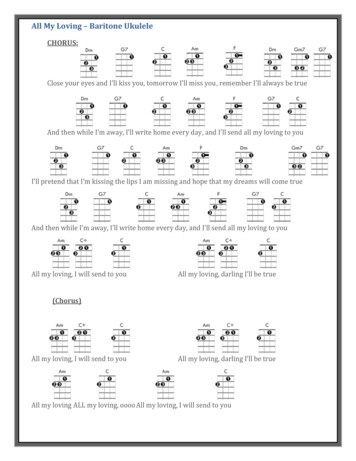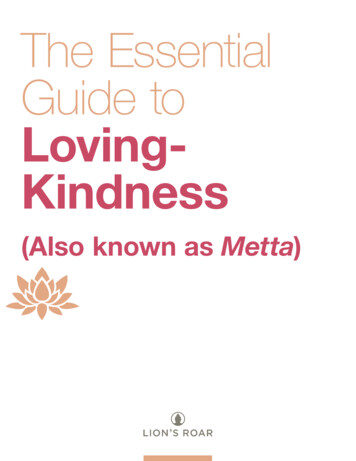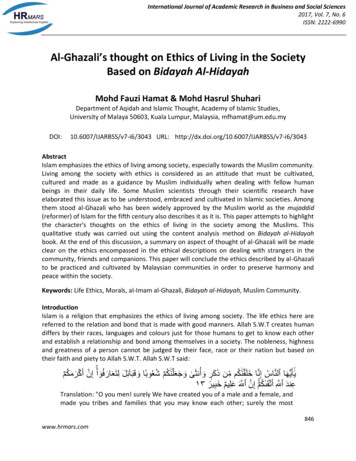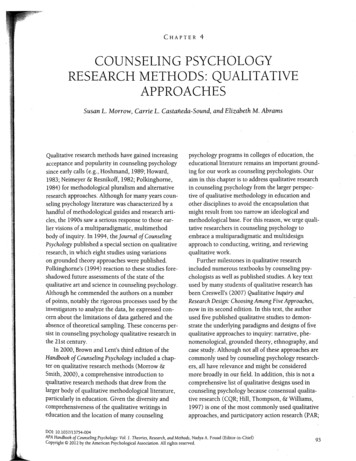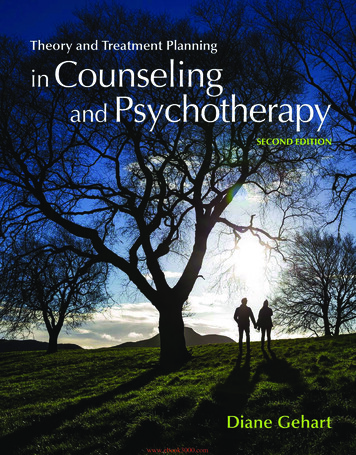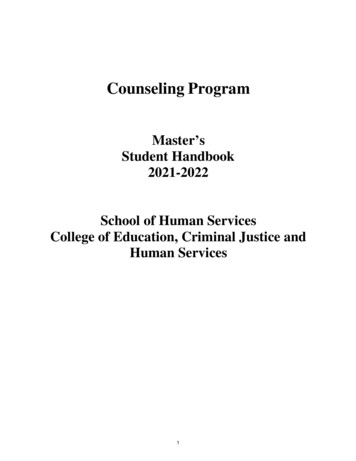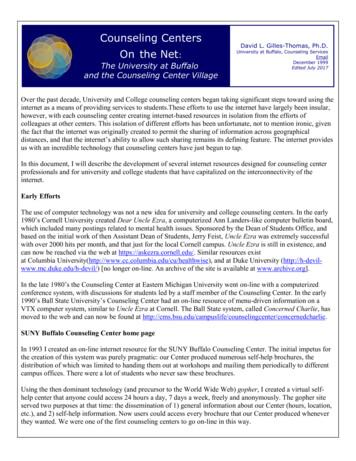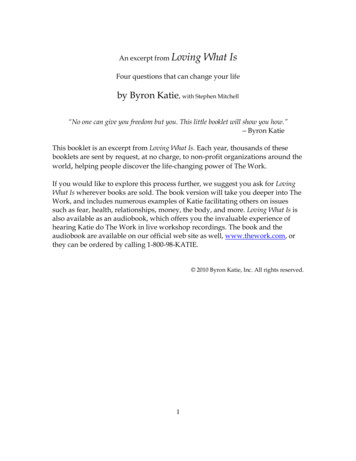
Transcription
An excerpt from LovingWhat IsFour questions that can change your lifeby Byron Katie, with Stephen Mitchell“No one can give you freedom but you. This little booklet will show you how.”—Byron KatieThis booklet is an excerpt from Loving What Is. Each year, thousands of thesebooklets are sent by request, at no charge, to non-profit organizations around theworld, helping people discover the life-changing power of The Work.If you would like to explore this process further, we suggest you ask for LovingWhat Is wherever books are sold. The book version will take you deeper into TheWork, and includes numerous examples of Katie facilitating others on issuessuch as fear, health, relationships, money, the body, and more. Loving What Is isalso available as an audiobook, which offers you the invaluable experience ofhearing Katie do The Work in live workshop recordings. The book and theaudiobook are available on our official web site as well, www.thework.com, orthey can be ordered by calling 1-800-98-KATIE. 2010 Byron Katie, Inc. All rights reserved.1
IntroductionThe Work of Byron Katie is a way to identify and question the thoughts thatcause all of the suffering in the world. It is a way to find peace with yourself andwith the world. The old, the young, the sick, the well, the educated, theuneducated—anyone with an open mind can do this Work.Byron Kathleen Reid became severely depressed while in her thirties. Over aten-year period her depression deepened, and Katie (as she is called) spentalmost two years rarely able to leave her bed, obsessing over suicide. Then onemorning, from the depths of despair, she experienced a life-changing realization.Katie saw that when she believed that something should be different than it is(“My husband should love me more,” “My children should appreciate me”) shesuffered, and that when she didn’t believe these thoughts, she felt peace. Sherealized that what had been causing her depression was not the world aroundher, but what she believed about the world around her. In a flash of insight,Katie saw that our attempt to find happiness was backward—instead ofhopelessly trying to change the world to match our thoughts about how it“should” be, we can question these thoughts and, by meeting reality as it is,experience unimaginable freedom and joy. Katie developed a simple yetpowerful method of inquiry, called The Work, that made this transformationpractical. As a result, a bed-ridden, suicidal woman became filled with love foreverything life brings.Katie‟s insight into the mind is consistent with leading-edge research incognitive neuroscience, and The Work has been compared to the Socraticdialogue, Buddhist teachings, and twelve-step programs. But Katie developedher method without any knowledge of religion or psychology. The Work isbased purely on one woman‟s direct experience of how suffering is created andended. It is astonishingly simple, accessible to people of all ages andbackgrounds, and requires nothing more than a pen and paper and an openmind. Katie saw right away that giving people her insights or answers was oflittle value—instead, she offers a process that can give people their own answers.The first people exposed to her Work reported that the experience wastransformational, and she soon began receiving invitations to teach the processpublicly.Since 1986, Katie has introduced The Work to millions of people around theworld. In addition to public events, she has introduced her Work intocorporations, universities, schools, churches, prisons, and hospitals. Katie‟s joyand humor immediately put people at ease, and the deep insights andbreakthroughs that participants quickly experience make the events captivating(tissues are always close at hand). Since 1998, Katie has directed the School forThe Work, a nine-day curriculum offered several times a year. The School is anapproved provider of continuing education units, and many psychologists,2
counselors, and therapists report that The Work is becoming the most importantpart of their practice. Katie also hosts an annual New Year‟s Mental Cleanse—afour-day program of continuous inquiry that takes place in southern Californiaat the end of December—and she sometimes offers weekend workshops. Audioand video recordings of Katie facilitating The Work on a wide range of topics(sex, money, the body, parenting) are available at her events and on her web site,www.thework.com.In March 2002, Harmony Books published Katie‟s first book, Loving What Is,written with her husband, the distinguished writer Stephen Mitchell. LovingWhat Is has been translated into twenty-eight languages. It was on bestseller listsacross the country. I Need Your Love—Is That True?, written with Michael Katz,and A Thousand Names for Joy, written with Stephen Mitchell were alsobestsellers. Question Your Thinking, Change the World was published in 2007, andKatie's latest book, Who Would You Be Without Your Story?, was published inOctober 2008. Tiger-Tiger, Is It True?, published in 2009, is Katie‟s first book forchildren; it is illustrated by Hans Wilhelm.Welcome to The Work.What Is IsThe only time we suffer is when we believe a thought that argues with what is.When the mind is perfectly clear, what is is what we want. If you want reality tobe different than it is, you might as well try to teach a cat to bark. You can tryand try, and in the end the cat will look up at you and say, “Meow.” Wantingreality to be different than it is is hopeless.And yet, if you pay attention, you‟ll notice that you think thoughts like thisdozens of times a day. “People should be kinder.” “Children should be wellbehaved.” “My husband (or wife) should agree with me.” “I should be thinner(or prettier or more successful).” These thoughts are ways of wanting reality tobe different than it is. If you think that this sounds depressing, you‟re right. Allthe stress that we feel is caused by arguing with what is.People new to The Work often say to me, “But it would be disempowering tostop my argument with reality. If I simply accept reality, I‟ll become passive. Imay even lose the desire to act.” I answer them with a question: “Can you reallyknow that that‟s true?” Which is more empowering?—“I wish I hadn‟t lost myjob” or “I lost my job; what can I do now?”The Work reveals that what you think shouldn‟t have happened should havehappened. It should have happened because it did, and no thinking in the worldcan change it. This doesn‟t mean that you condone it or approve of it. It justmeans that you can see things without resistance and without the confusion ofyour inner struggle. No one wants their children to get sick, no one wants to be3
in a car accident; but when these things happen, how can it be helpful tomentally argue with them? We know better than to do that, yet we do it, becausewe don‟t know how to stop.I am a lover of what is, not because I‟m a spiritual person, but because it hurtswhen I argue with reality. We can know that reality is good just as it is, becausewhen we argue with it, we experience tension and frustration. We don‟t feelnatural or balanced. When we stop opposing reality, action becomes simple,fluid, kind, and fearless.Staying in Your Own BusinessI can find only three kinds of business in the universe: mine, yours, and God‟s.(For me, the word God means “reality.” Reality is God, because it rules. Anythingthat‟s out of my control, your control, and everyone else‟s control, I call thatGod‟s business.)Much of our stress comes from mentally living out of our own business.When I think, “You need to get a job, I want you to be happy, you should be ontime, you need to take better care of yourself,” I am in your business. When I‟mworried about earthquakes, floods, war, or when I will die, I am in God‟sbusiness. If I am mentally in your business or in God‟s business, the effect isseparation. I noticed this early in 1986. When I mentally went into my mother‟sbusiness, for example, with a thought like “My mother should understand me,” Iimmediately experienced a feeling of loneliness. And I realized that every time inmy life that I had felt hurt or lonely, I had been in someone else‟s business.If you are living your life and I am mentally living your life, who is hereliving mine? We‟re both over there. Being mentally in your business keeps mefrom being present in my own. I am separate from myself, wondering why mylife doesn‟t work.To think that I know what‟s best for anyone else is to be out of my business.Even in the name of love, it is pure arrogance, and the result is tension, anxiety,and fear. Do I know what‟s right for me? That is my only business. Let me workwith that before I try to solve your problems for you.If you understand the three kinds of business enough to stay in your ownbusiness, it could free your life in a way that you can‟t even imagine. The nexttime you‟re feeling stress or discomfort, ask yourself whose business you‟re inmentally, and you may burst out laughing! That question can bring you back toyourself. And you may come to see that you‟ve never really been present, thatyou‟ve been mentally living in other people‟s business all your life. Just to noticethat you‟re in someone else‟s business can bring you back to your ownwonderful self.4
And if you practice it for a while, you may come to see that you don‟t haveany business either and that your life runs perfectly well on its own.Meeting Your Thoughts with UnderstandingA thought is harmless unless we believe it. It is not our thoughts, but theattachment to our thoughts, that causes suffering. Attaching to a thought meansbelieving that it‟s true, without inquiring. A belief is a thought that we‟ve beenattaching to, often for years.Most people think that they are what their thoughts tell them they are. Oneday I noticed that I wasn‟t breathing—I was being breathed. Then I also noticed,to my amazement, that I wasn‟t thinking—that I was actually being thought andthat thinking isn‟t personal. Do you wake up in the morning and say to yourself,“I think I won‟t think today”? It‟s too late: You‟re already thinking! Thoughts justappear. They come out of nothing and go back to nothing, like clouds movingacross the empty sky. They come to pass, not to stay. There is no harm in themuntil we attach to them as if they were true.No one has ever been able to control his thinking, although people may tellthe story of how they have. I don‟t let go of my thoughts—I meet them withunderstanding. Then they let go of me.Thoughts are like the breeze or the leaves on the trees or the raindrops falling.They appear like that, and through inquiry we can make friends with them.Would you argue with a raindrop? Raindrops aren‟t personal, and neither arethoughts. Once a painful concept is met with understanding, the next time itappears you may find it interesting. What used to be the nightmare is now justinteresting. The next time it appears, you may find it funny. The next time, youmay not even notice it. This is the power of loving what is.Putting the Mind on PaperThe first step in The Work is to write down your judgments about any stressfulsituation in your life, past, present, or future—about a person you dislike or asituation with someone who angers or frightens or saddens you. (Use a blanksheet of paper; or you can go to www.thework.com to the section called “TheWork,” where you‟ll find a Judge-Your-Neighbor Worksheet to download andprint.)For thousands of years, we have been taught not to judge—but let‟s face it,we still do it all the time. The truth is that we all have judgments running in ourheads. Through The Work we finally have permission to let those judgments5
speak out, or even scream out, on paper. We may find that even the mostunpleasant thoughts can be met with unconditional love.I encourage you to write about someone whom you haven‟t yet totallyforgiven. This is the most powerful place to begin. Even if you‟ve forgiven thatperson 99 percent, you aren‟t free until your forgiveness is complete. The 1percent you haven‟t forgiven them is the very place where you‟re stuck in allyour other relationships (including your relationship with yourself).If you begin by pointing the finger of blame outward, then the focus isn‟t onyou. You can just let loose and be uncensored. We‟re often quite sure about whatother people need to do, how they should live, whom they should be with. Wehave 20/20 vision about others, but not about ourselves.When you do The Work, you see who you are by seeing who you think otherpeople are. Eventually you come to see that everything outside you is a reflectionof your own thinking. You are the storyteller, the projector of all stories, and theworld is the projected image of your thoughts.Since the beginning of time, people have been trying to change the world sothat they can be happy. This hasn‟t ever worked, because it approaches theproblem backward. What The Work gives us is a way to change the projector—mind—rather than the projected. It‟s like when there‟s a piece of lint on aprojector‟s lens. We think there‟s a flaw on the screen, and we try to change thisperson and that person, whomever the flaw appears to be on next. But it‟s futileto try to change the projected images. Once we realize where the lint is, we canclear the lens itself. This is the end of suffering, and the beginning of a little joy inparadise.How to Write on the WorksheetI invite you to be judgmental, harsh, childish, and petty. Write with thespontaneity of a child who is sad, angry, confused, or frightened. Don‟t try tobe wise, spiritual, or kind. This is the time to be totally honest and uncensoredabout how you feel. Allow your feelings to express themselves, without any fearof consequences or any threat of punishment.On the next page, you‟ll find an example of a completed Judge-YourNeighbor Worksheet. I have written about my second husband, Paul, in thisexample (included here with his permission); these are the kinds of thoughts thatI used to have about him before my life changed. As you read, you‟re invited toreplace Paul‟s name with the appropriate name in your life.6
1. Who angers, confuses, saddens, or disappoints you, and why? What is itabout them that you don‟t like?I am angry at Paul because he doesn’t listen to me. I’m angry at Paul because hedoesn’t appreciate me. I don’t like Paul because he argues with everything I say.2. How do you want them to change? What do you want them to do?I want Paul to give me his full attention. I want Paul to love me completely.Iwant Paul to agree with me. I want Paul to get more exercise.3. What is it that they should or shouldn‟t do, be, think, or feel? What advicecould you offer?Paul shouldn‟t watch so much television. Paul should stop smoking. Paulshould tell me that he loves me. He shouldn’t ignore me.4. What do they need to do in order for you to be happy?I need Paul to listen to me. I need Paul to stop lying to me.I need Paul to sharehis feelings and be emotionally available. I need Paul to be gentle and kind andpatient.5. What do you think of them? Make a list. (Remember, be petty andjudgmental.)Paul is dishonest. Paul is reckless. Paul is childish. He thinks he doesn’thave tofollow the rules. Paul is uncaring and unavailable. Paul is irresponsible.6. What is it that you don‟t want to experience with that person again?I don‟t ever want to live with Paul if he doesn’t change. I don’t ever wantargue with Paul again. I don’t ever want to be lied to by Paul again.Inquiry: The Four Questions and Turnaround1. Is it true?2. Can you absolutely know that it‟s true?3. How do you react, what happens, when you believe that thought?4. Who would you be without the thought?and7to
Turn it around, then find at least three genuine, specific examples of how theturnaround is true in your life.Now, using the four questions, let‟s investigate the first statement from number 1on the example: Paul doesn’t listen to me. As you read along, think of someone youhaven‟t totally forgiven yet.1. Is it true? Ask yourself, “Is it true that Paul doesn‟t listen to me?” Be still. Ifyou really want to know the truth, the answer will rise to meet the question. Letthe mind ask the question, and wait for the answer that surfaces.2. Can you absolutely know that it’s true? Consider these questions: “Can Iabsolutely know that it‟s true that Paul doesn‟t listen to me? Can I ever reallyknow when someone is listening or not? Am I sometimes listening even when Iappear not to be?”3. How do you react, what happens, when you believe that thought? How doyou react when you believe that Paul doesn‟t listen to you? How do you treathim? Make a list. For example: “I give him „the look.‟ I interrupt him. I punishhim by not paying attention to him. I start talking faster and louder, and I try toforce him to listen.” Continue making your list as you go inside, and see howyou treat yourself in that situation and how that feels. “I shut down. I isolatemyself. I eat and sleep a lot, and I watch television for days. I feel depressed andlonely.” Notice all the effects of believing the thought Paul doesn’t listen to me.4. Who would you be without the thought? Now consider who you would bewithout the thought Paul doesn’t listen to me. Who would you be if you weren‟teven capable of thinking that thought? Close your eyes and imagine Paul notlistening to you. Imagine you don‟t have the thought that Paul doesn‟t listen (orthat he even should listen). Take your time. Notice what is revealed to you. Whatdo you see? How does that feel?Turn it around. The original statement, Paul doesn’t listen to me, when turnedaround, could become “I don‟t listen to Paul.” Is that as true or truer for you?When is it that you do not listen to Paul? Are you listening to Paul when you‟rethinking about him not listening to you? Find at least three genuine, specificexamples of how this turnaround is true in your life.Another turnaround is “I don‟t listen to myself.” A third is “Paul does listento me.” For each turnaround you discover, find at least three genuine, specificexamples of how the turnaround is true in your life.8
After sitting with the turnarounds, you would continue a typical inquiry with thenext statement written in number 1 on the Worksheet—Paul doesn’t appreciateme—and then with every other statement on the Worksheet.Your Turn: The WorksheetNow you know enough to try out The Work. First you‟ll put your thoughts onpaper. Simply pick a person or situation and write, using short, simple sentences.Remember to point the finger of blame or judgment outward. You may write fromyour present position or from your point of view as a five-year-old or twentyfive-year-old. Please do not write about yourself yet.1) Who angers, confuses, saddens, or disappoints you, and why? What is itabout them that you don’t like? (Remember: Be harsh, childish, and petty.) Idon‟t like (I am angry at, or saddened, frightened, confused, etc., by) (name)because .2) How do you want them to change? What do you want them to do? I want(name) to .3) What is it that they should or shouldn’t do, be, think, or feel? Whatadvice could you offer? (Name) should (shouldn‟t) .9
4) What do they need to do in order for you to be happy? (Pretend it‟s yourbirthday and you can have anything you want. Go for it!) I need (name)to .5) What do you think of them? Make a list. (Don‟t be rational or kind.)(Name) is .6) What is it that you don’t want to experience with that person again? Idon‟t ever want .Your Turn: The InquiryOne by one, put each statement on the Judge-Your-Neighbor Worksheet upagainst the four questions, and then turn around the statement you‟re workingon. (If you need help, refer back to the example in the section entitled "How toWrite on the Worksheet.") Throughout this process, explore being open topossibilities beyond what you think you know. There‟s nothing more excitingthan discovering the don‟t-know mind.It‟s like diving. Keep asking the question and wait. Let the answer find you. Icall it the heart meeting the mind: the gentler polarity of mind (which I call theheart) meeting the polarity that is confused because it hasn‟t been investigated.When the mind asks sincerely, the heart will respond. You may begin toexperience revelations about yourself and your world, revelations that cantransform your whole life, forever.Look at the first statement that you have written on number 1 of yourWorksheet. Now ask yourself the following questions:1. Is it true?Reality, for me, is what is true. The truth is whatever is in front of you, whateveris really happening. Whether you like it or not, it‟s raining now. “It shouldn‟t beraining” is just a thought. In reality, there is no such thing as a “should” or a“shouldn‟t.” These are only thoughts that we impose onto reality. Without the“should” and “shouldn‟t,” we can see reality as it is, and this leaves us free to actefficiently, clearly, and sanely.When asking the first question, take your time. The Work is aboutdiscovering what is true from the deepest part of yourself. You are listening foryour answers now, not other people‟s, and not anything you have been taught.This can be very unsettling, because you‟re entering the unknown. As youcontinue to dive deeper, allow the truth within you to rise and meet the question.Be gentle as you give yourself to inquiry. Let this experience have youcompletely.10
2. Can you absolutely know that it’s true?If your answer to question 1 is yes, ask yourself, “Can I absolutely know that it‟strue?” In many cases, the statement appears to be true. Of course it does. Yourconcepts are based on a lifetime of uninvestigated beliefs.After I woke up to reality in 1986, I noticed many times how people, inconversations, the media, and books, made statements such as “There isn‟tenough understanding in the world,” “There‟s too much violence,” “We shouldlove one another more.” These were stories I used to believe, too. They seemedsensitive, kind, and caring, but as I heard them, I noticed that believing themcaused stress and that they didn‟t feel peaceful inside me.For instance, when I heard the story “People should be more loving,” thequestion would arise in me “Can I absolutely know that that‟s true? Can I reallyknow for myself, within myself, that people should be more loving? Even if thewhole world tells me so, is it really true?” And to my amazement, when Ilistened within myself, I saw that the world is what it is—nothing more, nothingless. Where reality is concerned, there is no “what should be.” There is only“what is,” just the way it is, right now. The truth is prior to every story. Andevery story, prior to investigation, prevents us from seeing what‟s true.Now I could finally inquire of every potentially uncomfortable story, “Can Iabsolutely know that it‟s true?” And the answer, like the question, was anexperience: No. I would stand rooted in that answer—solitary, peaceful, free.How could no be the right answer? Everyone I knew, and all the books, saidthat the answer should be yes. But I came to see that the truth is itself and willnot be dictated to by anyone. In the presence of that inner no, I came to see thatthe world is always as it should be, whether I opposed it or not. And I came toembrace reality with all my heart. I love the world, without any conditions.If your answer is still yes, good. If you think that you can absolutely knowthat that‟s true, it‟s always fine to move on to question 3.3. How do you react, what happens, when you believe that thought?With this question, we begin to notice internal cause and effect. You can see thatwhen you believe the thought, there is an uneasy feeling, a disturbance that canrange from mild discomfort to fear or panic.After the four questions found me, I would notice thoughts like “Peopleshould be more loving,” and I would see that they caused a feeling of uneasiness.I noticed that prior to the thought, there was peace. My mind was quiet andserene. This is who I am without my story. Then, in the stillness of awareness, Ibegan to notice the feelings that came from believing or attaching to the thought.And in the stillness, I could see that if I were to believe the thought, the resultwould be a feeling of unease and sadness. When I asked, “How do I react when I11
believe the thought that people should be more loving?” I saw that not only did Ihave an uncomfortable feeling (this was obvious), but I also reacted with mentalpictures to prove that the thought was true. I flew off into a world that didn‟texist. I reacted by living in a stressed body, seeing everything through fearfuleyes, a sleepwalker, someone in an endless nightmare. The remedy was simplyto investigate.I love question 3. Once you answer it for yourself, once you see the cause andeffect of a thought, all your suffering begins to unravel.4. Who would you be without the thought?This is a very powerful question. Picture yourself standing in the presence of theperson you have written about when they‟re doing what you think theyshouldn‟t be doing. Now, just for a minute or two, close your eyes, and imaginewho you would be if you couldn‟t think this thought. How would your life bedifferent in the same situation without this thought? Keep your eyes closed andwatch them without your story. What do you see? How do you feel about themwithout the story? Which do you prefer—with or without your story? Whichfeels kinder? Which feels more peaceful?For many people, life without their story is literally unimaginable. They haveno reference for it. So “I don‟t know” is a common answer to this question. Otherpeople answer by saying, “I‟d be free,” “I‟d be peaceful,” “I‟d be a more lovingperson.” You could also say, “I‟d be clear enough to understand the situation andact efficiently.” Without our stories, we are not only able to act clearly andfearlessly; we are also a friend, a listener. We are people living happy lives. Weare appreciation and gratitude that have become as natural as breath itself.Happiness is the natural state for someone who knows that there‟s nothing toknow and that we already have everything we need, right here now.Turn it around.To do the turnaround, rewrite your statement. First, write it as if it were writtenabout you. Where you have written someone‟s name, put yourself. Instead of“he” or “she,” put “I.” For example, “Paul doesn‟t appreciate me” turns aroundto “I don‟t appreciate Paul” and “I don‟t appreciate myself.” Another type is a180-degree turnaround to the extreme opposite: “Paul does appreciate me.” Foreach turnaround, find at least three genuine, specific examples of how theturnaround is true in your life. This is not about blaming yourself or feelingguilty. It‟s about discovering alternatives that can bring you peace.The turnaround is a very powerful part of The Work. As long as you thinkthat the cause of your problem is “out there”—as long as you think that anyone12
or anything else is responsible for your suffering—the situation is hopeless. Itmeans that you are forever in the role of the victim, that you‟re suffering inparadise. So bring the truth home to yourself and begin to set yourself free.Inquiry combined with the turnaround is the fast track to self-realization.The Turnaround for Number 6The turnaround for statement number 6 on the Judge-Your-Neighbor Worksheetis a bit different from the others. We change “I don‟t ever want to ” to “I amwilling to ” and “I look forward to .” For example, “I don‟t ever want to arguewith Paul again” turns around to “I am willing to argue with Paul again” and “Ilook forward to arguing with Paul again.”This turnaround is about embracing all of life. Saying—and meaning—“I amwilling to ” creates openness, creativity, and flexibility. Any resistance that youmay have is softened, allowing you to lighten up rather than keep hopelesslyapplying willpower or force to eradicate the situation from your life. Saying andmeaning “I look forward to ” actively opens you to life as it unfolds.It‟s good to acknowledge that the same feelings or situation may happenagain, if only in your thoughts. When you realize that suffering and discomfortare the call to inquiry, you may actually begin to look forward to uncomfortablefeelings. You may even experience them as friends coming to show you whatyou have not yet investigated thoroughly enough. It‟s no longer necessary towait for people or situations to change in order to experience peace andharmony. The Work is the direct way to orchestrate your own happiness.13
Questions and AnswersQ I have a hard time writing about others. Can I write about myself?A If you want to know yourself, I suggest you write about someone else. PointThe Work outward in the beginning, and you may come to see that everythingoutside you is a direct reflection of your thinking. It is all about you. Most of ushave been pointing our criticism and judgments at ourselves for years, and ithasn‟t solved anything yet. Judging someone else, inquiring, and turning itaround is the fast path to understanding and self-realization.Q How can you say that reality is good? What about war, rape, poverty, violence, andchild abuse? Are you condoning them?A How could I condone them? I simply notice that if I believe they shouldn‟texist when they do exist, I suffer. Can I just end the war in me? Can I stop rapingmyself and others with my abusive thoughts and actions? If not, I‟m continuingin myself the very thing I want to end in the world. I start with ending my ownsuffering, my own war. This is a life‟s work.Q So what you’re saying is that I should just accept reality as it is and not argue with it.Is that right?A The Work doesn‟t say what anyone should or shouldn‟t do. We simply ask,“What is the effect of arguing with reality? How does it feel?” This Workexplores the cause and effect of attaching to painful thoughts, and in thatinvestigation we find our freedom. To simply say that we shouldn‟t argue withreality just
Loving What Is Four questions that can change your life by Byron Katie, with Stephen Mitchell "No one can give you freedom but you. This little booklet will show you how." —Byron Katie This booklet is an excerpt from Loving What Is. Each year, thousands of these booklets are sent by request, at no charge, to non-profit organizations .
